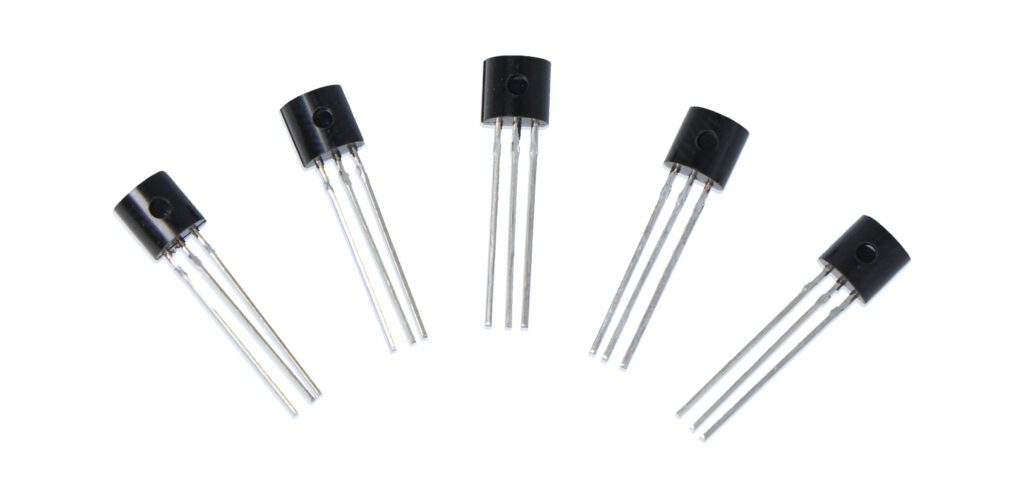Table of Contents:
Want to understand what a PNP transistor is and how it is used in electronics? This article will introduce you to the concept and operation of the PNP transistor, its key roles in electronic circuits, and suggest how to choose the right component for your project. Explore the fascinating world of semiconductors now!
PNP transistor - basic information
The PNP transistor
is an essential electronic component that plays a key role in many devices – from simple circuits to sophisticated computer systems. The PNP transistor has a unique structure that differs from the other popular variety of NPN transistors. It contains three P-N-P semiconductor layers, hence the name. The first and last layers (P) are P-type layers that are positively charged, and the middle layer (N) is a negative layer.
The principle of the PNP transistor is based on controlling the current flowing through the two P-type semiconductor layers with a small amount of current entering the N-layer. In practice, the PNP transistor acts as a switch to control a large current with a small signal.
The PNP transistor is therefore a key component in electronics that converts signals into current and is essential in the amplification of signals. Its unique properties make it an invaluable ingredient in the world of modern technology.
Structure and mechanism of operation of the PNP transistor
The PNP transistor
consists of three semiconductor layers: two P-type layers, which are positively charged, and a middle N-type layer, which is negatively charged. It is the structure of these layers that determines the performance characteristics of a PNP transistor. The key elements of a PNP transistor are the emitter, base and collector. The emitter and collector are P-type layers, while the middle lot is an N-type base.
In principle, the mechanism of operation of a PNP transistor is based on controlling the current flowing through the P layers by means of the current supplied to the N layer.
When a small negative current is introduced into the base, the PNP transistor will start conducting current from the emitter to the collector. This current path is reversed compared to an NPN-type transistor, which is an important difference in the performance of the two types. Thus, the internal structure of the PNP transistor determines its unique functional properties, which enable the construction of advanced electronic devices.
Application of PNP transistors in practice
The PNP transistor, thanks to its unique properties, finds a number of applications in practice. Its ability to control large currents with small signals makes it ideal for use in amplifier circuits. It is often found in audio and video amplifiers, where it is used to amplify a signal to a level that can be converted into sound or video.
Another practical application of the PNP transistor is power regulation. It can be found in power systems, where it regulates the voltage and current supplied to various sections of the device. Thus, we can enjoy stable and reliable operation of our equipment.
PNP transistors also play a key role in switching circuits, where they act as fast and precise switches. Their ability to switch currents quickly and precisely makes them an indispensable component in many modern technologies. Understanding the role and application of the PNP transistor is crucial for anyone who wants to explore electronics.
Comparison of PNP and NPN transistors.
Transistor comparison
PNP
i NPN is a key element in understanding the functioning of these essential electronic components. The similarities and differences between them determine their specificity and appropriate application. Both the PNP transistor and the NPN transistor consist of three semiconductor layers, but differ in the direction of current flow and the type of semiconductor layers.
In a PNP transistor, current flows from the emitter to the collector, while in an NPN transistor, current flows from the collector to the emitter. The base in a PNP transistor is N-type, while in an NPN transistor it is P-type. The comparison does not end there.
PNP and NPN transistor acting as switches work well in different contexts. While the PNP transistor is ideal for amplification and power regulation circuits, the NPN transistor is often used in logic and signal processing circuits. This comparison of PNP and NPN transistors underscores their diversity of applications and shows how crucial a role they play in the field of electronics.
How to choose the right PNP transistor for the project?
The selection of a PNP transistor for our electronic project is a key step that definitely affects the efficiency and effectiveness of our device. When choosing the right PNP transistor, we need to pay attention to several criteria that will help us match the component to the specifics of our project. The first is the maximum voltage rating that the PNP transistor is capable of handling.
When choosing a PNP transistor, we must also pay attention to the maximum current that can flow through the transistor. This is extremely important, especially for systems that are expected to generate large amounts of power. The frequency at which it is able to respond is also not insignificant.
Each PNP transistor has its own characteristic ripple value, indicating the frequency to which it is capable of responding. Selecting a PNP transistor with a higher ripple value than required by the electronic design will allow the circuit to operate smoothly and quickly. Choosing the right transistor is the key to success in any electronic project. Remember to carefully analyze the technical specifications and requirements of our project before making a choice.
FAQ - frequently asked questions about PNP transistors
In the FAQ section you will find answers to the most common questions about the PNP transistor. Have you wondered what semiconductor layers make up a PNP transistor? Or maybe you are interested in what practical applications this component has? Our FAQ will provide you with key information to help you understand the function and application of the PNP transistor in various contexts.
Although PNP and NPN transistors are similar in design, they differ in key aspects, such as the direction of current flow. Understanding these differences is key to properly selecting and using a transistor in your project. Do you have additional questions about PNP transistors? Leave them in the comments!
How useful was this post?
Click on a star to rate it!
Average rating 5 / 5. Vote count: 1
No votes so far! Be the first to rate this post.




















